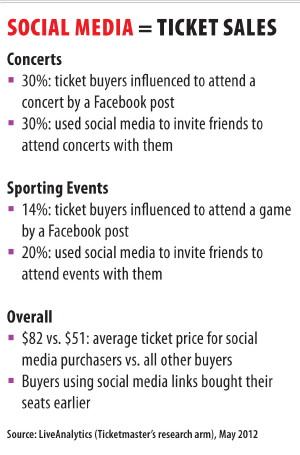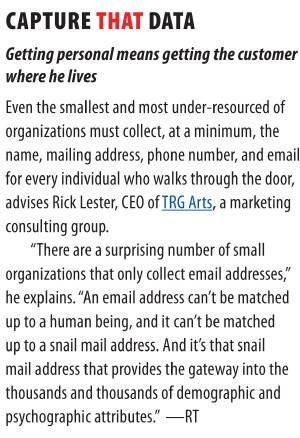Special Reports
Ticketing is Getting Personal
 . . . And changing beyond all recognition
. . . And changing beyond all recognition
It’s been some time since ticketing was just about putting “butts in the seats.” Whereas ticketing used to close the sale, it now has the potential to start the marketing and sales process, initiating a chain of patron communication and recognition—often mobile and personalized—and leading to greater customer loyalty and higher sales.
The arts and entertainment sector is behind in this domain. A tracking study in 2012 by GroupofMinds found 44 percent of arts marketing emails were opened on smartphones. Analysis of browsers by theaters for online sales has shown as much as 36 percent coming from smartphones. INTIX, in San Antonio, TX), when, in an unusual keynote, nine ticketing company CEOs stood up to say that their systems were now about interfacing with customers through all channels—web site, social media, smartphones, and so on. Yes, systems need to deliver a great ticketing product on the back end, but it is the front end that is key now.
With most of today’s major ticketing systems, it is possible to treat patrons as individuals, personalize messages to them—to relate. It’s a practice known in the trade as Customer Relationship Management (CRM). To enter this world, start thinking of “winning hearts and minds,” and ask yourself two questions:
1. The customer knows and remembers what his relationship is to you; does your organization remember what its relationship is to him?
2. If you contact the customer on his smartphone, you are reaching him personally; is your message relevant to him, specifically?
 The effects of CRM were reflected last year at an industry-wide conference (INTIX, in San Antonio, TX), when, in an unusual keynote, nine ticketing company CEOs stood up to say that their systems were now about interfacing with customers through all channels—web site, social media, smartphones, and so on. Yes, systems need to deliver a great ticketing product on the back end, but it is the front end that is key now.
The effects of CRM were reflected last year at an industry-wide conference (INTIX, in San Antonio, TX), when, in an unusual keynote, nine ticketing company CEOs stood up to say that their systems were now about interfacing with customers through all channels—web site, social media, smartphones, and so on. Yes, systems need to deliver a great ticketing product on the back end, but it is the front end that is key now.The likes of Ticketmaster have been haemorrhaging business for years, as venues choose to relate to customers directly, usually by switching to their own systems, such as Tessitura. At any scale, the preference has been to have direct control. Ticket agencies’ high fees and multiple charges are also challenging to explain to customers in the current marketplace; they can be a deterrent. Even Live Nation is running promotional “fee-free” days or adding the term “inclusive” to its prices.
The 360-degree Customer View
 The 360-degree view of each customer puts an end to separate databases for the online newsletter, the mailing list, and various campaigns for membership, subscriptions, donations, sponsorships, and so on. Combining them all into one list with ticket purchasers enables organizations to track their interactions with customers at all touch-points and really understand their behavior. This is the foundation for “getting personal” with customers.
The 360-degree view of each customer puts an end to separate databases for the online newsletter, the mailing list, and various campaigns for membership, subscriptions, donations, sponsorships, and so on. Combining them all into one list with ticket purchasers enables organizations to track their interactions with customers at all touch-points and really understand their behavior. This is the foundation for “getting personal” with customers.This growing awareness of the social aspect of ticket-buying has caused system-suppliers to enable purchasers to Tweet their attendance details or post them to Facebook with a deep link so their followers or friends can buy tickets to the same event. What is often called ‘’word-of-mouth’’ is actually equally important before as after an event.
Box Office as Data Manager
The democratization of ticketing, with the ability to make purchases through many channels, does rather put customers in control, buying what they want, when they want, and how they want. Some box offices are not happy about these trends. But the walls around the box office are falling down, not least because their managers are now seen as data administrators, guardians of that ‘’database of truth,’’ and are often included in the marketing and/or development departments. (See Capture that Data) As one manager described it, they must now “forensically interrogate the database” to find out why customers attended the last show and what might motivate them to attend the next.
The Smartphone Cometh
With all these methods for customer contact and sales, the smartphone—or the tablet on the sofa—becomes key. This is where all the interaction takes place. The challenge for the organization is that it might operate inside Facebook, or on Twitter, to name just two options. With the customer in control, he can “pull” the content he wants and your organization can “push” content specific to him and, ensuring it is presented correctly for the window view, make the experience personal. For instance, you wouldn’t send the same message to subscribers as you would to single-ticket buyers.
Many organizations avoid asking customers to log in until they have viewed What’s On and are ready to complete a purchase. But the smartphone only requires the user to log in once, ever, even if the user is navigating from his Twitter or Facebook account. The login goes straight to the organization’s database for customer records and profiles, making it possible to send back content that is relevant to him personally. Most systems also let customers see their booking history, past and near future, and to manage their account for updating.
With ticketing systems this personal, you can add value-added services to the ticket purchase, such as vouchers for program books, interval drinks, parking, and so on. Alerts can be sent to people asking if they are interested in an event, perhaps sent after 70 percent of tickets are sold, or if it is coming up next week. Alerts can extend to traffic disruption expected on their route before a performance, or offers at specific restaurants for a late table booking.
Clearly we have moved way beyond the scenario of the box office clerk serving a queue of customers. Technology, used smartly and creatively, enables organizations to be more open and accessible to their customers in a way most customers appreciate. Win their hearts and minds and they will be your fans.

Roger Tomlinson is a London-based management and marketing consultant, working in the arts and entertainment sectors. An expert on integrated solutions and developing online technologies for ticketing and marketing, he has authored several books including Full House: Turning Data Into Audiences and Boxing Clever, Developing and Managing a Website. He also produces the The Ticketing Institute information web site.





 FEATURED JOBS
FEATURED JOBS

 RENT A PHOTO
RENT A PHOTO


